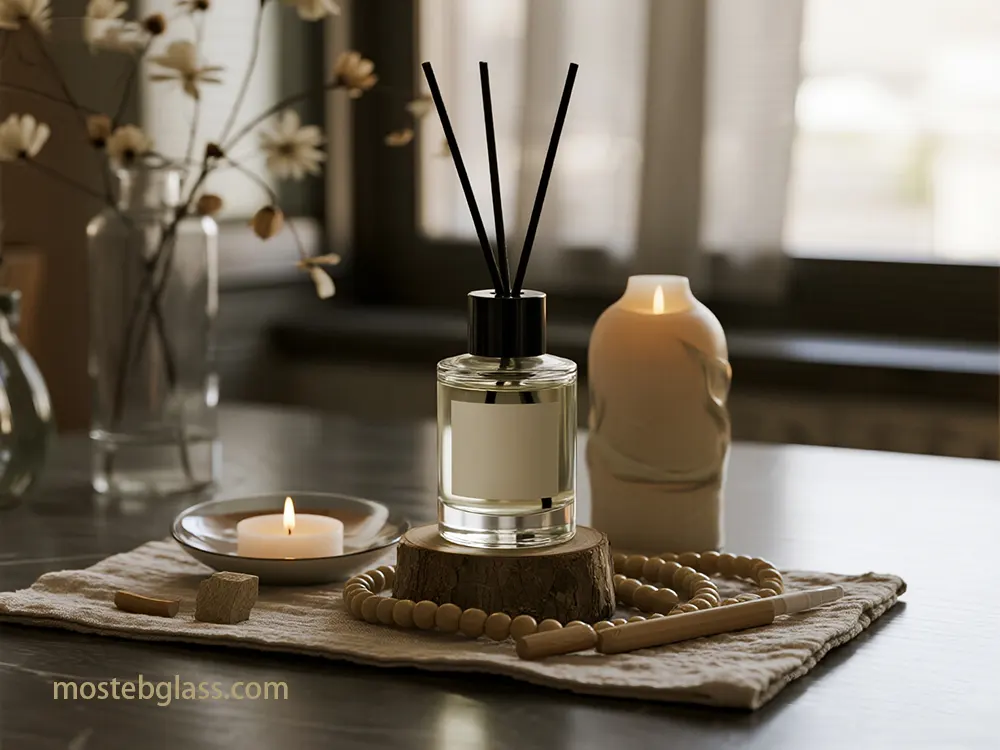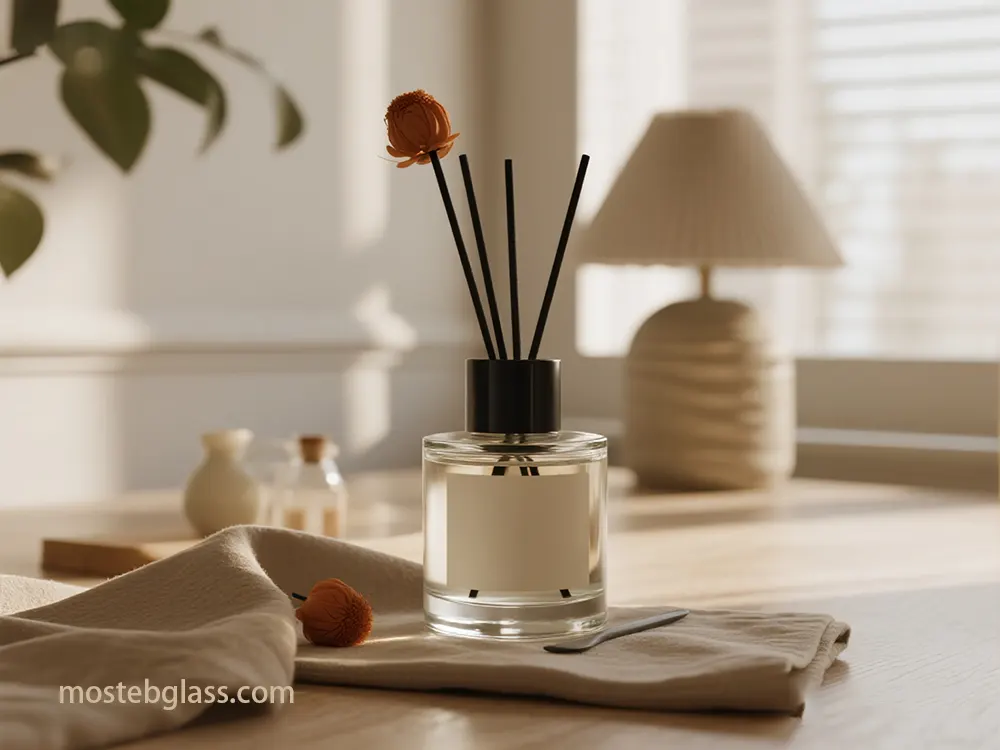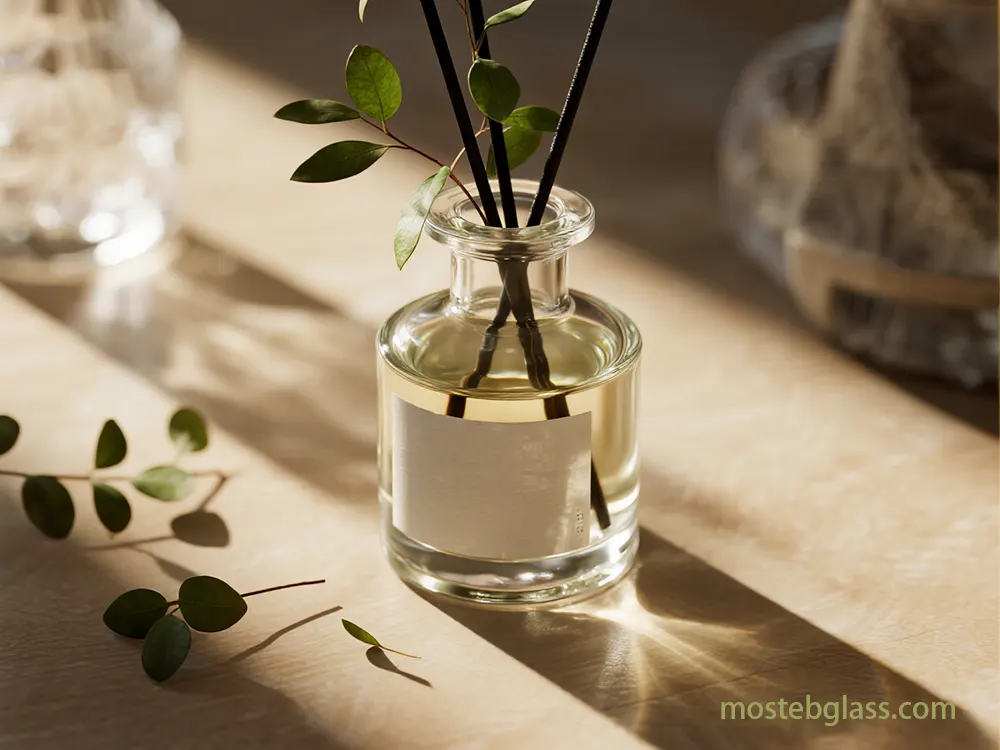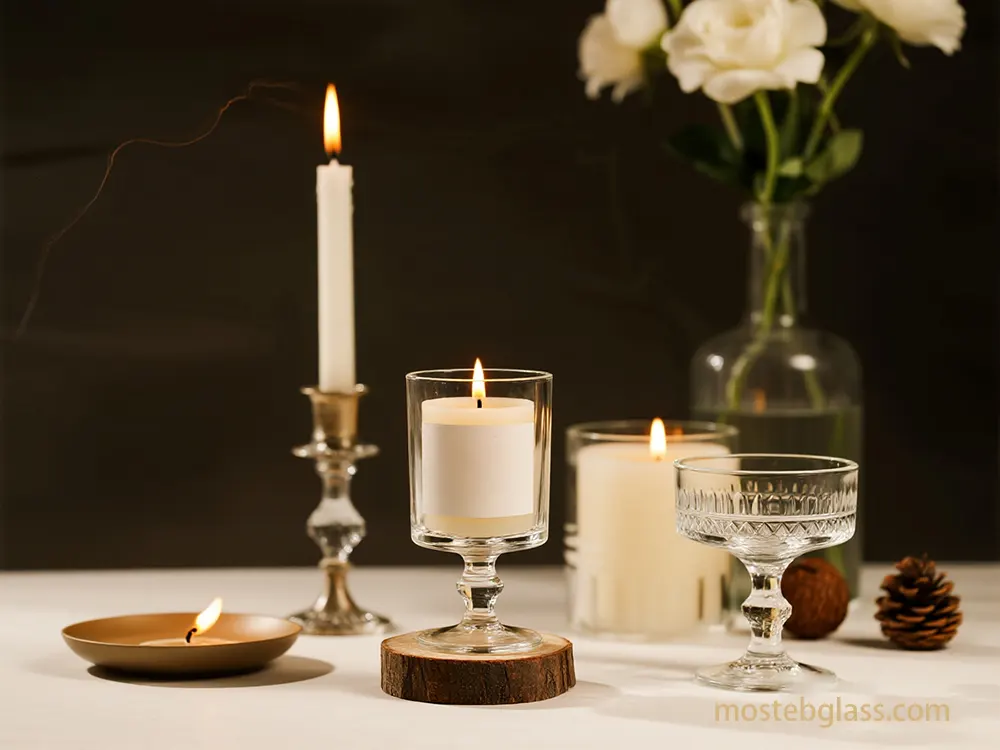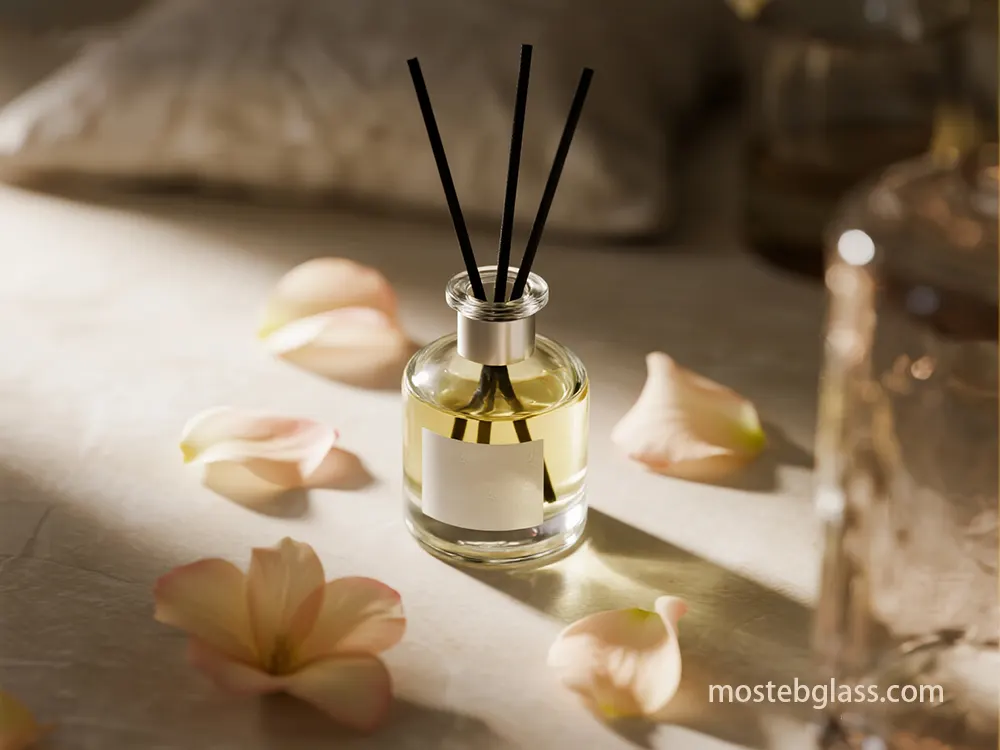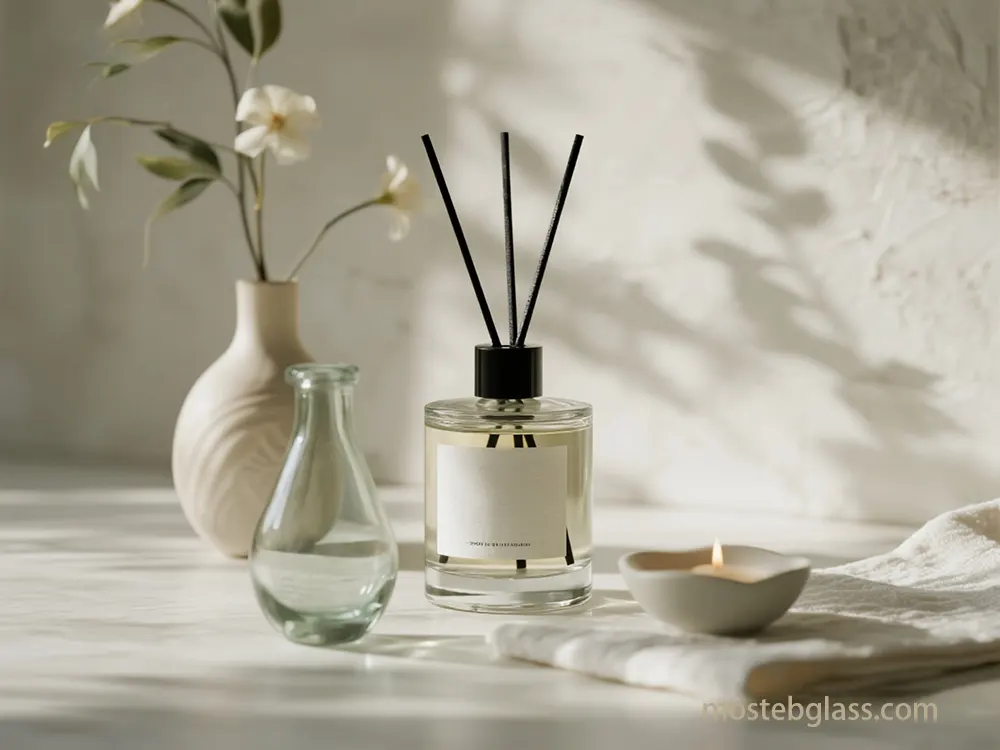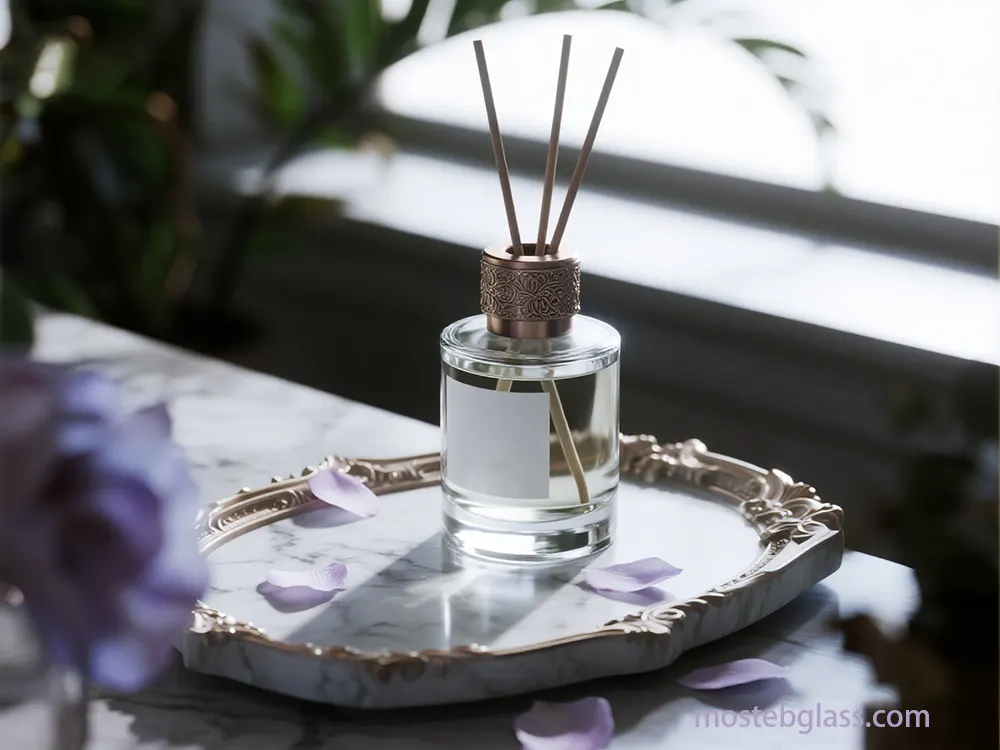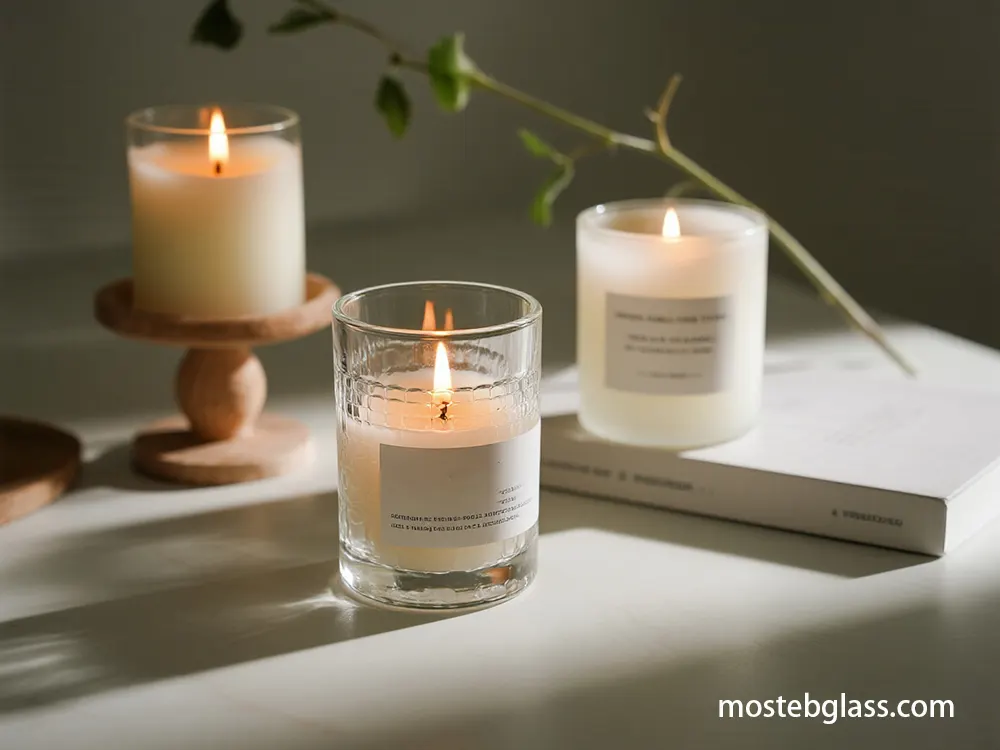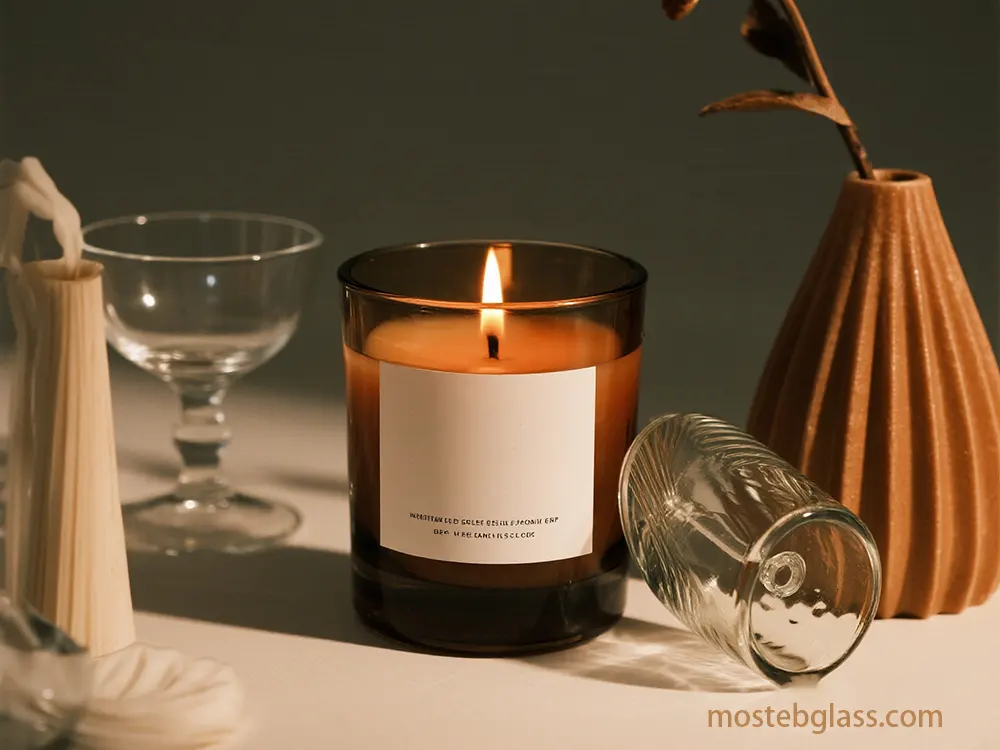1. 执行摘要
Color & Shape:
In addition to clear, colored options (black, gray, amber) provide an antique and luxurious quality, along with themed colored ambient light. Jars also can vary in shape (prism, apothecary, cylinder, hexagon, square, straight-sided, etc.) and geometric shapes offer modern appeal. Luxury elements can also include double walled construction or detailed embossing.
Lids & Customization:
Lids (glass, tinplate, aluminum, cork, bamboo—using silicone rings) provide a closure and aesthetic treatment to the candle line, with the benefits of preserving the fragrance up to 24 months. Higher end suppliers often use extensive customization (patterns and designs, and/or monograms or initials, and even hand painted) to help a brand separate themselves from their competition by offering a differentiating identity and story.
3.3. Finishing Precision
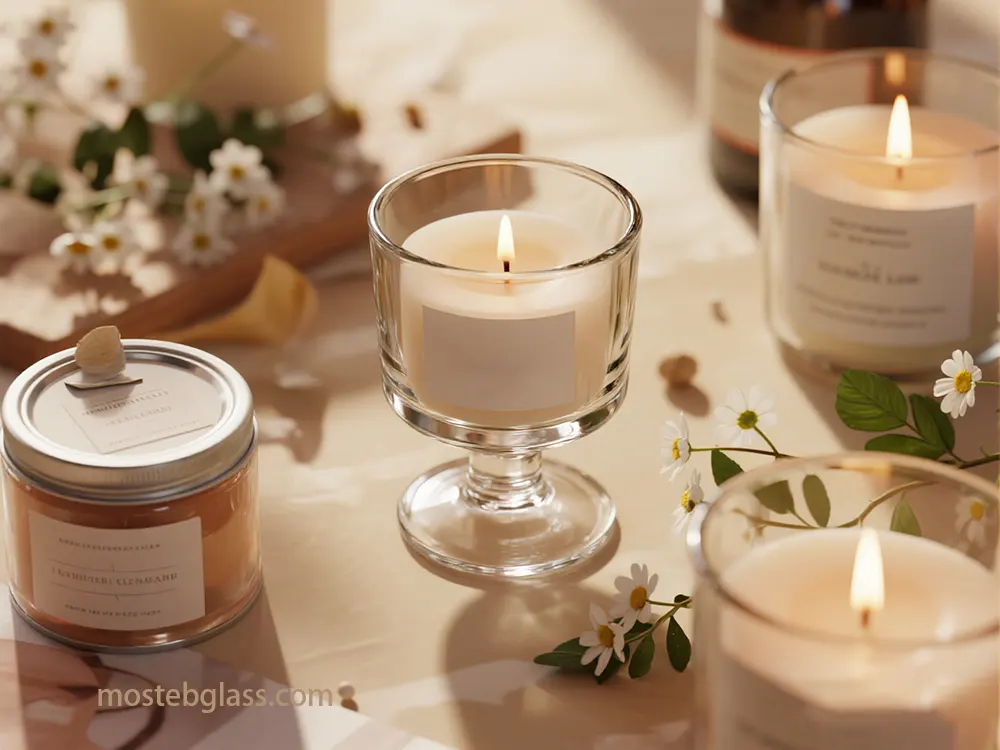
Advanced manufacturing and post-production finishing provide a significant differentiating factor among premium suppliers.
Molding Techniques:
Advanced molding includes press-and-blow, blow-and-blow, and Narrow Neck Press and Blow (NNPB).IS (Individual Section) machines can produce more than 600 containers/minute.CNC machining allows for high precision mold making. Precision Glass Molding (PGM) allows for high-precision components based on manufacturing without grinding, while MNPGM molds may use different materials including tungsten carbide to achieve precision without grinding.
Annealing processes:
- Controlled cooling (or annealing) was important to minimize internal waste to ensure a more substantial glass without cracking. Typically, glass is heated in a range of 454–482 °C and then cooled and tempers the glass in proper conditions; if it is not properly annealed the glass can become brittle. Post-production Finishing Techniques:
- Acid Etching – Hydrofluoric acid provides a satin-frosted, durable finish that has flexibility
- of form. Laser Etching
- – High-powered lasers create permanent marks or designs into glass that can be used for complex aesthetics. Vacuum Metallization
– In a vacuum, a very thin metal layer (70 – 100 nm aluminum) can be applied to surfaces in a brilliant mirror-like and luxurious construct with reflective bonds to glass [greater than 85% reflectivity].
Powder Coating
- – Dry pigments or resins (chemicals) in powder form are electrostatically adhered to glass fillets and can provide UV protection to glass and aesthetically pleasing finishes, however, the finishing process of powder coating must be specialized for glass. Electrostatic Coating
- – A relatively environmentally friendly process involves charged liquid droplets to spray coat materials uniformly and efficiently over flat surfaces such as glass. Screen-Printing
- – Ink often ceramic ink (also manufactured to US FDA specifications) is forced through a stencil as a screen printing mask and then adhered to glass after being baked into the glass by heating to as high as 600 °C (temperatures for injected tempered safety glass). There is permanence of colors with the use of ceramic inks which may also include metallic and etched-types. 4. Innovation and Customization Capabilities
In a premium glass jar supplier for candles, innovation and customization capabilities shine through some combination of bespoke design, material science, and leading-edge technology.
4.1. Bespoke Design and Rapid Prototyping
- The star of the show is taking a distinct brand vision and turning it into a tangible product. Custom Molds:
- Some advanced manufacturing utilizes custom molds (CNC-machined from aluminum for speed and precision) and be able to form very unique geometries. Custom silicone molds have expanded the diversity of intricate and personalized designs because of their ability to withstand high temperatures and flexibility. Design Flexibility:
- Premium suppliers can offer even more design flexibility in creating intricate patterns, logos, or custom artwork using techniques (such as acid etching) to maximize personalization and meet consumer demand.
- Rapid Prototyping (Speculative): The premium candle glass jar suppliers are likely using rapid prototyping (e.g., 3D printed mold inserts or mock-ups) to iteratively develop custom designs all while shortening their development cycles and speeding time to market for more complicated luxury projects. 4.2. Material Innovation and Progressive Glass Formulations
- Innovation also relates to the composition of glass and sustainable alternatives. Progressive Glass Formulations:
- Research has further enhanced aspects like thermal shock resistance, clarity or a reduction in mass, whilst maintaining strength. Borosilicate glass already has superior thermal qualities. Incorporating Recycled Content:
- The verifiable post-consumer recycled (PCR) content represents a major innovation. Premium suppliers are actively improving the percentage of PCR, complying to certifications such as SCS Global Services, Cradle to Cradle,RCS and GRS. Glass bottles are 100% recyclable, and for every 10 percent cullet (i.e. reproduction of a recycled glass) brings down the energy consumption by 3 percent in manufacture. Lighter Glass:
- Research has developed glass that is thirty percent lighter than glass manufactured fifty years ago, with resulted cost savings in transportation, and climate impact (including carbon emissions). Recent lighter weight ranges from companies like Ardagh Glass Packaging-Europe are using up to 80 percent cullet (i.e recycled glass) in drink bottles, equal to twelve percent reduced carbon impact. 4.3. Application of New-Fangled Finishing Techniques
- There is a continuous development of new finishing techniques that provide radical visualisation, as well as visual or tactile functionality. Beyond Finishes:
Premium suppliers are constantly changing and exploring new things as they move away from finishes, including the ability to feel coated, multi-layer coatings, multi-faceted anti-scratch treatments, and smart coatings.
Use of Digital Technology:
The advancement of NFC (near field communication) or QR codes is increasingly seen on glass packaging to educate and facilitate storytelling in the branding context, and also provide to consumers engagement, communicate authenticity, and anti-counterfeiting, thereby increasing interactive luxury.
Parametric Design and Generative AI (Speculative):
- Forward-thinking suppliers might use parametric design and generative AI to rapidly explore design possibilities, optimizing for aesthetics, material efficiency, and manufacturability, pushing design boundaries. 4.4. Lead Times, MOQs, and IP Protection
- Innovation and customization need practical support. Lead Times, and MOQs:
- Competitive lead times and flexible MOQs associated with custom designs are critical. Automation can cut lead times.Highly unique products may entail lead times too long to be efficient. Nonetheless, suppliers are honest about lead times to manage expectations. Quantities such as 10,000+ from China can lead to bulk discounts which would be a cost-effective option for the buyer. Intellectual Property (IP) Protection:
Strong IP protection is critical for bespoke designs. There must be long-term contracts which would protect IP rights, including the scope of rights, and the geographical area.Confidentiality and non-disclosure agreements (NDAs) should be included. NNN (nondisclosure, noncompete, and non-circumvent) is very important for manufacturers in china. Contracts must include protections, such as trademark and design registrations, and infringement protections.
If a premium Mosteb candle glass jar supplier excels in these three areas, then they will offer truly differentiated products, and they can meet the expectations of the luxury marketplace, while providing their clients a competitive advantage.
- 5. Operational Efficiency, and Supply Chain Resilience For a premium Mosteb candle glass jar supplier, operational efficiency and supply chain resilience is vital to ensure that quality can be maintained, orders are delivered on time, and disruptions can be managed effectively.
- 5.1. Predictable and Reliable Lead Times Lead times must be predictable!
- Improving lead times with automation in glass manufacturing leads to more consistent lead times. Robotics and Industry 4.0 platforms can provide 17% more throughput. Data Analytics:
Understanding performance data and analyzing production data can sharpen processes and procedures to minimize waste and produce reliable lead estimates.
5.2. Stringent Quality Control and Minimal Defect Rates
- Top quality means a near-statistical zero defect rate with heavy use of quality inspection. KPIs:
- Suppliers measure damage rate (less than 2%), return rate (less than 1%), pass rates on stress testing, and overall equipment effectiveness (OEE). Advanced Inspection Technologies:
- AI based machine vision systems are capable of inspecting reflective and transparent glass and also measure and classify defects (scratches, chips, cracks, bubbles, inclusions) at high speed, accuracy and repeatability. Digitally connected IoT sensor data combined with manufacturing execution systems (MES) feed:Real-time quality data; suppliers can intervene when tracking products of lower quality. Third Party Services:
Independent verification for objectivity, suppliers can measure defect rates, color consistency, and roundness tolerances and provide evidence that the inspection process was compliant with ASTM standards (F2179).
5.3. Robust and Resilient Supply Chain
- Sustainable solutions communication and dependable delivery are the foundations of resilient supply chains for premium product manufacturers. Sourcing:
- Premium suppliers compliment raw material/cullet qualification with available geo-diversification that minimizes the risk of single source suppliers. Knowing the multiple suppliers of a key ingredient via validation of purity, and having suppliers with the ability to source materials from multiple countries provides production flexibility. AI/ML software can provide awareness of likely swings in demand to inform supply or production inventory levels. A real-time dashboard can consolidate supplier, shipment, and customer inventory data to provide situational awareness that enable proactive decision making. Blockchain (though still speculative) would improve KPIs and sustainability.
Buffer Inventory&Scenario Modeling:
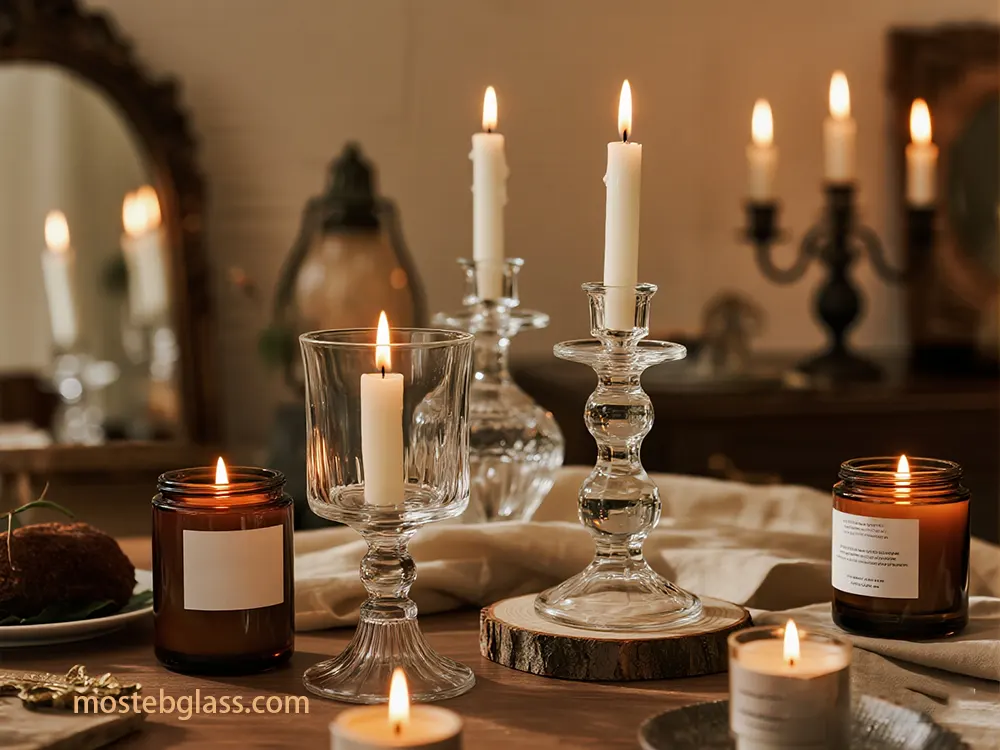
Contingency plans using safety stock for inventory and scenario modeling for demand or supply disruptions (including natural disasters and geopolitical tensions) can diminish disruptions.
Supply Chain Flexibility:
Reducing logistics networks through direct suppliers can ultimately shorten lead times to production. Integrating controls for modular inventory that adjusts to changing trends or levels of demand can help enhance value.
Near-shoring&Reshoring:
- Beyond certifications, factories should demonstrate sustainable operational practices: extensive incorporation of recycled glass (cullet), strategic use of alternative energy, energy-efficient electric melting/hybrid furnace technologies, and exploration of carbon capture/storage (CCS) solutions.Advanced water management (recycling) and robust waste reduction programs are also critical indicators. Flexible contractual agreements:
- Opportunity to switch suppliers quickly, reduce minimum order quantities (MOQs), and alternative routings provides flexibility. Minimize Damaged and Lost Products in Transit:
Advanced technology can help reduce damages during shipment of fragile glass products.
KPI tracking&Resiliency auditing:
- Having multiple sets of KPIs and continuously measuring various elements of the supply chain (e.g., >95% supplier on-time delivery should identify many physical distribution weaknesses) and conducting routine audits will help identify weaknesses in supply chain resiliency. Tier 2 supplier knowledge/visibility:
- Recognizing key supplier locations and capabilities (Tier 2) is important to mitigate risk. Business continuity plans (BCP):
- BCP for any product should include replacing tools, multiple sources for redundant raw materials/ingredients, and alternative suppliers for regulatory approvals without interruption. By employing these methods, a high-end Mosteb candle glass jar supplier secures high-quality products and the assurance luxury brands expect.
6. Sustainability and Ethical Sourcing Practices
A premium Mosteb candle glass jar supplier will have an unshakeable commitment to environmental sustainability and ethical sourcing as an important differentiator.
- 6.1. Sustainability Certifications and Verifiable Recycled Content This is where Transparency and third party verification enter the equation.
- 数字化转型: PCR content:
- US states have begun to implement PCR content mandates (California: 25% in 2025, 50% in 2030; New Jersey: 35% in 2024).PCR (Post-Consumer Recycled) glass is the next best thing to not using new material at all, it is great to include in glass products since it will eliminate the collection and extraction of virgin materials and got a lot lower carbon emissions than using virgin materials (1 kg recycled glass replaces ~1.2 kg virgin materials).Additionally, it is worth mentioning that glass can be recycled nearly 100%, although high levels of recycled glass (like 30) may lead to color changes; to do that high level you need specialized furnaces/ovens.The EU has a glass recycling rate of 80.8% as of 2023. 6.2. Ethical behavior in the supply chain is critical
- Ethical Labour: Enforce and maintain strict policies against child and forced labour. Your policies should include verifying worker ages, paying good wages, and ensuring the worker’s safety and well-being.
- Transparency: Manufacturers should trace the origins of raw materials to prevent unethical practices. Regular third-party audits are extremely important; for example, regular audits to help the organization understand if labour rights violations exist. Transparency allows to build trust which is important to starting and completing due diligence; transparency allows issues to be resolved and potentially improved.
- Supplier’s Code of Conduct: A supplier’s code of conduct (similar to) is an extremely important first step to binding a supplier’s labour standards to ethical labour rights.
- Fair Trade: There are examples like AfriCraft that demonstrates commitment to Fairtrade through (recycled wine glasses).
- 6.3. Life Cycle Assessment (LCA) and Environmental Impact A primary differentiator for companies today is their understanding, measuring, and minimizing their environmental impact.
- Cradle to Cradle LCA: The only LCA process. The whole life cycle of a product is evaluated, from the raw material to recycling, with scientific protocol of measuring and managing the life cycle of a product.
- Major Environmental Effects: Melting glass in the furnace is the greatest impact. All other activities are non-melting. Only <10% of the total energy is used in transporting raw materials/cullet.
Closed-Loop Recycling:
Reuse glass as glass, or as cullet equivocally decreases raw material and energy demand. One ton of recycled cullet saves 700 kg of CO2 emissions.
Sustainable Manufacturing Innovations:
Hybrid furnaces that combine electrical and conventional fuels (80% renewable energy) to improve CO2 emissions are being tested. The glass industry is exploring renewable heat sources, improving energy efficiency, developing climate-neutral glass (Eco2Bottle), moving to 30% lighter containers, and 70% less energy to produce glass. Modern production emits roughly 50% less CO2 than that produced fifty years ago.
6.4. Challenges and Experience in sustainability
- 认证: Infrastructure Issues:
- Existing infrastructure may not support PCR content goals, causing supply/demand imbalances. Regulatory Barriers:
Regulations are not designed with circularity in mind, resulting in limited use of recycled glass.
- Incentive Programs – Some industries (like flat glass) often do not have a legal obligation to show proper dismantling/sorting for waste.
- Green Washing – Trust in eco-friendly claims has seen a drastic decline making it imperative that verifiable certifications are disclosed.
- Consumer Awareness – Providing consumers with information about sustainable packaging will help to draw demand.
- A conscientious Mosteb candle glass jar supplier is working to address some of these challenges by investing in sustainable innovations, engaging with certifications, and being open about their ethical supply chain. 7. Geographic Sourcing and Strategic Market Access
The geographic location of a supplier of Mosteb candle glass jars impacts sourcing, ability to leverage logistics, sourcing costs and access to market.
7.1. Global Manufacturing Hub, Specializations
- The global landscape for glass manufacturing has unique regional strengths. Dominant regions:
- Europe (83.3 billion bottles/jars produced in 2021), North America, Western Europe, and East Asia (China, Japan). Global players:
- AGC Inc., Fuyao Glass, Saint-Gobain, Guardian Glass, O-I Glass, Ardagh Glass Packaging, Verallia UK Ltd. Importance of China:
- China is important because of strong manufacturing capabilities and growing domestic demand, and it provides larger purchases when buyers want substantial bulk orders (more than 10,000 units). Regional specializations:
India is good at metal jar craftsmanship with artisanal styled jars; Europe and North America specialize in premium styled ceramic vessels, leading to optimizing sourcing across multiple regions.
Overall growth:
- Global glass manufacturing market G/M $235.8 billion (2024) to $248.8 billion (2033), CAGR 5.4%, and G/C $65.2 billion (2025) to $91.1 billion (2035), India market estimated growth 6.0%. 7.2. Sourcing Benefits and Cost Savings
- Location determines raw material source and cost, labor cost, and technology. Raw Material Source:
- Proximity to quality silica sand and other raw materials decreases transportation costs and guarantees a supply. Diverse sources of cullet/raw materials with purity verification help mitigate supply chain risks. Areas with lower labor costs provide competitive pricing but balance against quality and ethics.
- Technology and Expertise: Regional access to advanced manufacturing (IS machines, CNC molds, precision sculpt, glass molding).
- Volume Discounts and Duty Benefits: High-volume production areas offer bulk discounts for product. Strategic sourcing provides additional duty benefits.
7.3. Logistics Efficiency and Transportation Costs
Logistics efficiency is very important for fragile glass.
Transportation Infrastructure:
Exploits for global distribution rely on strong networks: ports, rail, roads. The entire global glass logistics market is estimated at $15 billion (2023), expected to hit $20 billion by (2028).
Weight and Cost:
- Glass is heavier than plastic, which requires higher transportation costs. As a result, it is important to maximize efficiency in logistics. Lightweighting:
- Lightweighting glass bottles significantly reduce carbon emissions and transportation costs (e.g., Ardagh’s wine bottles at 360g reduced emissions by 12%). Smart Packaging:
- Digital technologies (near field communication, QR codes, etc.) promote better visibility and tracking of the supply chain. Supply Chain Volatility:
- A glass shortage can drive up prices, ensuring business recovery begins with a resilient supply chain. 7.4.Closer Markets and Demand
- The location and strategic offer exists with access to related markets and demand. Expanding of the food/beverage market, consumer demand for eco-friendly packaging, acceptance of glass packaging all work together to create strong market demand.
Luxury Packaging Trends:
Interest in luxury packaging in the US (in the alcoholic beverages space particularly) is increasing demand for premium glass products; high-end candles (spending more than 39% glass jars by 2035).
- Pharmacies Market Segment: Large demand and growth anticipated (>USD 31 billion by 2034) growth for safe non-reactive, sustainable glass packaging.
- Cost of “free” molds: Sustainability drives interest with eco-friendly transportation and packaging (including fuel-efficient vehicles and recycled materials).
- Nearshoring / Reshoring: It is easier to mitigate some of the global risk of supply chain by using local suppliers in nearshoring/reshoring your manufacturing.
- Considering these factors, a premium Mosteb candle glass jar supplier provides the most value, efficiencies, and responsiveness. 8. Supplier Partnership and Brand Alignment
A premium Mosteb candle glass jar supplier is a true partner that aligns with the brand’s values, allows for timely input and engagement, and invites rigorous support.
8.1. Supplier Reputation and Proactive Communication
- Reputation is built on trust, reliability and transparency. Trust & Loyalty:
- Luxury brands build long partnerships with suppliers by remaining consistent in performance, treatment, and ethical behavior. Proactive Communication:
- Premium suppliers are proactive communicators, particularly in times of challenge (e.g., a shortage of glass), minimizing the impact, and again co-creating a plan of action. Transparency & Openness:
- Suppliers will be much more open in their communication, share information and be part of any conversations where there is business value added, with more insights into both the understanding of needs and valuable services (e.g., capturing the use of a new material, advice about raw material prices). Communication Protocols:
- Define what should happen, what channels should be used, what follow up looks like, the structure of feedback, and everyone’s role. 8.2.Innovation and Technical Support Collaboration
Connected suppliers extend their client’s research and development and design capabilities.
Supplier Technical Ability:
- 增长需求: R&D Collaboration:
- Continuous supplier clients can collaborate on a consistent basis through co-creation with the connected supplier. A connected supplier contributes their experience on new materials, new design opportunities, cost effectiveness, increasing efficiency, leading to unique and innovative packaging solutions. Monitoring Market Factors:
- Conscious suppliers will consistently stay in touch with glass technology development, processing finishing innovation, and sustainable technologies and ideas, developing solutions for their clients to keep them relevant and innovative in their own packaging designs. 8.3.Cultural Alignment and Strategic Goals
- The alignment of values and strategic goals serves as a foundation for collaboration. Brand Values and Ethics:
- Strategic partners must align with the mission, values, and ethics of the client, even in the realm of sustainable packaging. Clients want a partner who will do their brand justice. Shared Vision for Innovation:
Sharing a vision for innovation, including goals around sustainability and packaging (again, increasing PCR and reducing carbon footprint), will strengthen partnerships and help clients feel progress is being made together.
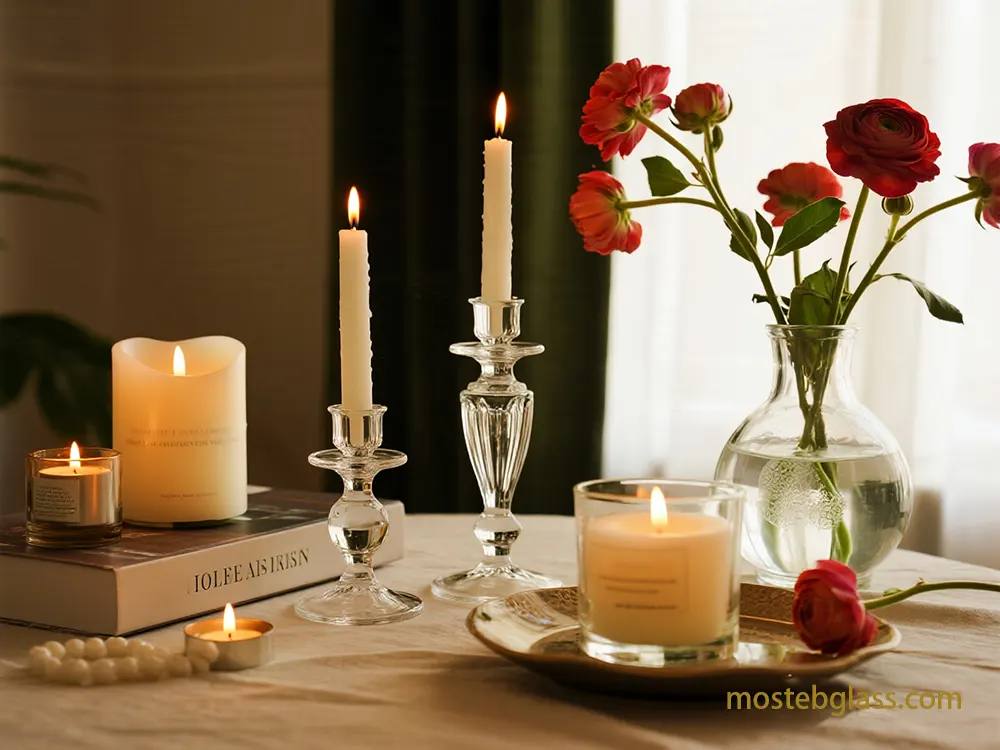
Willingness to Collaborate and Problem-Solve:
Collaboration in problem-solving and entertaining supplier recommendations and ideas with curiosity will contribute to overcoming challenges.
Continuous Improvement:
Commitment to continuous improvement, including establishing regular quality controls and feedback loops that allow for ongoing change.
- As many brands are global, it requires suppliers to be sensitive to their clients’ culture(s) in their packaging designs as well. If local preferences are important, including colour choices, key typography styles and symbols, these will also need to be done in such a way as to not compromise brand identity. 8.4. Legal and Contractual Issues
- Both parties are protected by strong legal protections Contracts should address and protect all IP rights in scope and regions.
- Confidentiality & NDAs: Confidentiality and NDAs (non-disclosure agreements) should protect the confidential information (designs, materials, processes, etc.) with clear definitions on what’s confidential, the obligations and penalties for breach.
- NNN Agreements: In manufacturing region, e.g. China, NNN agreements (nondisclosure, non-compete, and non-circumvention) are crucial, because it restricts copies or otherwise abusing your products or designs.
Trademarks & Designs:
Contracts should also include terms addressing registering or maintaining trademarks and designs, and to address any possible infringements.
- 8.5. Market Trends and Challenges in Partner Relationships An agile relationship with suppliers is crucial in our everchanging market.
- Sustainability Expectations – Suppliers balance costs and performance along with premium quality, sustainability and usability.
- Regulatory Changes – Suppliers provide assistance to clients with their compliance obligations around evolving complex regulations related to consumer and product risk and safety.
Raw Material and Supply Chain Issues
– Sustainability and raw material availability issues impact costs. Global disruptions (geopolitical tensions and natural disasters) also drive raw materials and supply chain resiliency in partnership and collaboration activities expecting diverse product lines and short cycles.
- Personalization and E-commerce Opportunities – With the advancement of e-commerce and personalization, suppliers must find innovative and efficient ways to fulfill commodity obligations beyond price.
- In considering these leading requirements, the potential value of a premium Mosteb candle glass jar supplier reaches important strategic value; your partner will be enabling your brand success, market differentiation and innovation. 9. Closing and Strategic Recommendations
- Choosing a premium Mosteb candle glass jar supplier is a strategic choice that includes brand positioning, product integrity, sustainability, and other strategic aspects. Differentiating factors go beyond just specifications understanding and include a well-rounded view of material science, manufacturing, innovation, operations, ethical practices, and the relationship dynamics at play. Differentiating Factors:
- Product Excellence: Advanced glass (borosilicate, crystal), premium heat-resistant glass; lead-free (17 but showing purity); optical clarity; sophisticated design (intricate mold, multiple shapes, quality lids) and finishes (vacuum metallization, HD printing, advanced etching).
- 文化敏感性: Bespoke design (custom molds/silicone molds); material innovation (advanced glass, confirmable high PCR content); cutting-edge finishing; a potential use of digital technologies.
Operational Efficiency & Supply Chain Resiliency:
Consistent lead times (leverage automation, data use, etc.); quality control processes (low defect rates/AI inspection); steady or improved supply chain (multiple sources, digital transformation, buffering inventories, flexible contracts, nearshoring).
- Premium suppliers compliment raw material/cullet qualification with available geo-diversification that minimizes the risk of single source suppliers. Knowing the multiple suppliers of a key ingredient via validation of purity, and having suppliers with the ability to source materials from multiple countries provides production flexibility. Meeting credible certification standards (SCS and backtracking to help protect, C2C, GRS, CIRCPACK); ethical labor practices in open sourcing; sufficient LCA; closed-loop recycling; and sustainable manufacturing practices (hybrid furnaces, lighter weight glass).
- Geographic Sourcing and Strategic Access to Markets: Global advantages (Europe and China) using manufacturing hubs for sourcing (advantage), utilizing and shipping logistics/efficiency, and affordability (fundamental shift) for new branded goods while being flexible for luxury packaging and market access to pharmaceutical trends.
- Supplier Partnership & Brand Synergy: Solid reputation, proactive and transparent communication, strong technical support, cultural and values alignment, mutual interest in innovation, collaborative problem-solving, and strong IP protection (NDAs and NNN agreements).
- Recommendations for Selection of Supplier: Complete Technical Audit:
Audit and deep dive into manufacturing processes beyond what is normally investigated (molding, annealing, finishing), ASTM F2179, ISO 9001, and level of investment in AI-assisted inspection and Industry 4.0.
Verifiable Sustainability Credentials:
- Suppliers with recognized third-party certifications (SCS, GRS, C2C), genuine standing behind ethical sourcing, request unfettered LCA reports, and emissions/carbon reduction roadmap, recycled content increases Innovation and Customization Desire:
- Research and development, develop a unique mold (CNC, silicone), demonstrate interest in co-development, timeline/MOQs related to customization, consideration of new technologies (digital print, smart-print, etc). Test the Supply Chain Resiliency:
- Develop processes for reviewing diversification, buffer inventory, real-time visibility. Request for business continuity plans and responsiveness to business disruption scenarios with emphasis on nearshoring. Partnership alignment and communication:
- Responsiveness, and adherence to value systems; request evidence of long-term clients, examples of collaboration on innovative projects, the relevance of contractual agreements to protect IP, NNN agreements related to any international sourcing. Think about Total Cost of Ownership (TCO):
Include costs around quality assurance, defect ratios, supply chain risks, and other areas of value that come from innovation and partnering. In the end, a more expensive unit cost for a truly premium, reliable and innovative supplier can save brand owners significant money and add immense brand value.
By implementing these suggestions, brands are locking in a premium Mosteb candle glass jar supplier as a partner that builds in innovation, sustainability, and sustainable market dominance.
Custom Glass Ornaments
Wholesale Candle Jars
- Wholesale Diffuser Bottles Wholesale Glass Vases
- Latest Insights Case Study: Overcoming Challenges in Large Glass Diffuser Bottles Manufacturing
- Custom Glass Christmas Ornaments – Driving Brand Differentiation in Seasonal Markets Customization in Glass Ornaments: Unlocking Opportunities for Differentiated Branding
- Case Study: Custom Glass Unique Diffuser Bottles Manufacturing for a Spain Brand Large Diffuser Bottles: Redefining Luxury Home Fragrance Packaging
- Sustainability in Glass Flower Vase Manufacturing: Global Market Trends Comment
- Submit your opinion get a free quote
Complete our quote request form or email us at
- to receive a customized quote from our product specialists. Company
- Phone/Whatsapp Select a product
- glass candle jars Reed Diffuser Bottle
- glass vases Quantity
- contact our Product Expert Send us a message freely if you have any questions. We’ll get back to you within 30 minutes via email at
- , and we’ll adhere to the privacy policy to protect your information. full name
email adress




